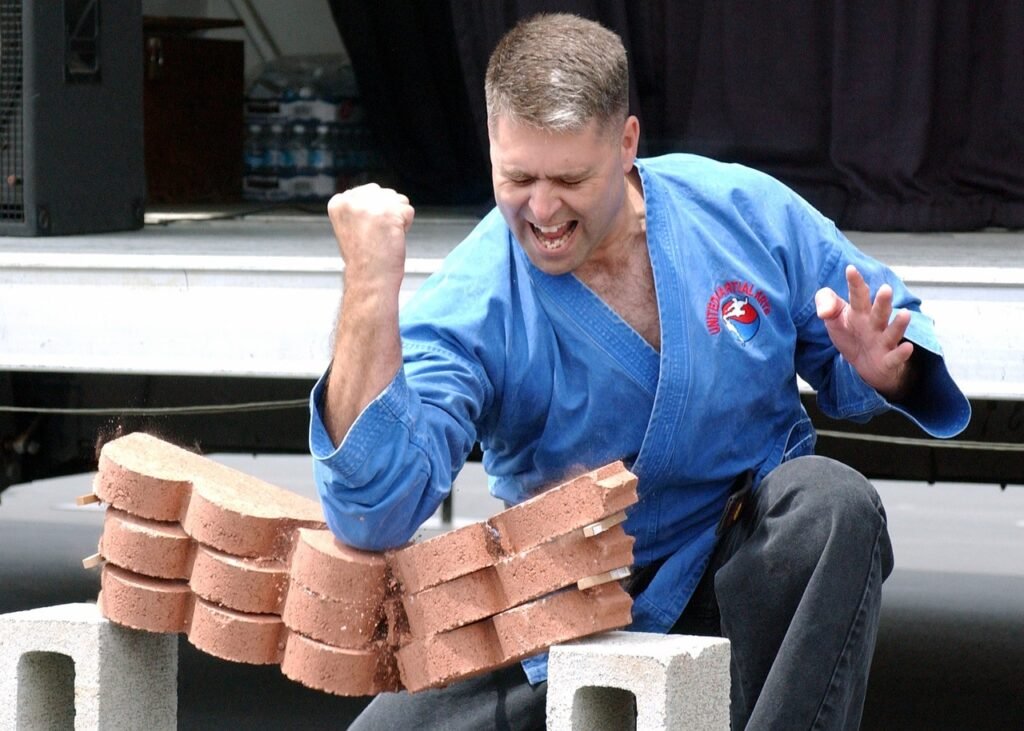The Ultimate Fighting Championship (UFC) stands as the premier organization in the mixed martial arts (MMA) world.
Drawing athletes and audiences from around the globe.
Governed by a comprehensive set of rules and regulations.
The UFC ensures that competition remains fair and fighters’ safety is prioritized.
The establishment and continual evolution of these rules are pivotal in maintaining both the integrity of the sport and the well-being of its participants.
Initially, the UFC was characterized by a minimalistic approach to rules.
Which allowed for a broader range of techniques and strategies.
However, as the sport gained popularity and scrutiny.
It became evident that a structured rule set was essential to protect athletes and enhance the sport’s legitimacy.
The introduction of the Unified Rules of Mixed Martial Arts in 2001 marked a significant milestone in this evolution.
Setting standardized guidelines for permissible techniques, weight classes, and fight duration.
The importance of these rules cannot be overstated.
They not only ensure a level playing field but also minimize the risk of serious injury, fostering a competitive yet safe environment.
The regulatory body, often comprising state athletic commissions, continuously reviews and updates these rules to adapt to the sport’s dynamic nature and emerging trends.
For instance, moves that were once considered acceptable might be banned if they are deemed too dangerous or if they undermine the sport’s ethical standards.
Over time, the UFC’s regulatory framework has grown more sophisticated.
addressing various aspects of the sport, from doping control to fight conduct.
This progression reflects a broader commitment to maintaining the sport’s reputation and ensuring that it remains a legitimate and respected form of athletic competition.
By understanding the evolution and significance of these rules.
one can better appreciate the delicate balance the UFC strikes between excitement and safety in the world of mixed martial arts.

The Importance of Fighter Safety
In the realm of mixed martial arts (MMA), fighter safety is a paramount concern.
Serving as a cornerstone for the sport’s integrity and longevity.
The physical nature of MMA inherently exposes athletes to a myriad of risks.
including concussions, broken bones, and other severe injuries.
These risks are not merely hypothetical;
they manifest in the form of long-term health repercussions that can affect fighters’ quality of life well beyond their active years in the sport.
Concussions, in particular, represent a significant danger 😉 in MMA.
Repeated head trauma can lead to chronic traumatic encephalopathy (CTE).
A debilitating condition that affects cognitive function and emotional 😭 stability.
Moreover, the potential for broken bones and joint dislocations is high, given the sport’s combination of striking and grappling techniques.
These injuries can necessitate lengthy recovery periods and, in some cases, may prematurely end a fighter’s career 🚩 .
Recognizing these inherent dangers, the Ultimate Fighting Championship (UFC) has implemented stringent measures to enhance fighter safety.
These measures include mandatory medical examinations before and after fights 🥷.
the presence of professional medical staff during events.
and the enforcement of strict rules regarding permissible techniques.
By banning certain moves deemed excessively dangerous, such as 12-6 elbow strikes and soccer kicks to the head of a grounded opponent.
the UFC aims to reduce the likelihood of catastrophic injuries.
Furthermore, the UFC has introduced advanced training protocols.
and educational programs to inform fighters about the best practices for minimizing injury risks ⚡.
This includes guidance on proper techniques, conditioning regimens, and recovery strategies.
Additionally, the promotion has embraced technological advancements.
such as improved protective gear and monitoring systems, to better safeguard its athletes.

In conclusion, the emphasis on fighter safety within the UFC is a multifaceted approach that addresses both immediate and long-term health concerns.
By implementing comprehensive safety measures and continuously refining their practices.
The UFC strives to protect its fighters while maintaining the competitive spirit of MMA.
Overview of Banned Moves
The Ultimate Fighting Championship (UFC) has established a comprehensive set of rules aimed at ensuring the safety of its fighters.
As part of these regulations, several highly effective moves have been banned due to their potential to cause severe harm.
Among the most notable of these banned techniques are headbutts, groin strikes, and 12-6 elbow strikes.

Headbutts are prohibited in the UFC because they can cause significant damage to both the person delivering and the person receiving the strike.
The force generated by a headbutt can result in serious injuries such as concussions, facial fractures, and cuts.
The unpredictability and high impact of headbutts led to their ban to reduce the risk of long-term injuries.
Groin strikes are another move that has been banned for obvious reasons.
A strike to the groin can cause excruciating pain and potentially long-lasting damage to the reproductive organs.
Despite the use of protective gear, the sensitivity and vulnerability of the area make groin strikes particularly dangerous.
Therefore, to maintain a fair and safe competition, groin strikes are strictly prohibited in the UFC.
The 12-6 elbow strike, which involves bringing the elbow down in a vertical motion from the 12 o’clock position to the 6 o’clock position, is also banned.
This move is considered particularly dangerous because of the concentrated force it delivers.
The ban on 12-6 elbow strikes aims to prevent severe injuries such as skull fractures and deep cuts.
which can occur due to the sharp angle and power of the strike.
These banned moves highlight the UFC’s commitment to fighter safety.
While these techniques may be effective, their potential to cause serious injury outweighs their utility in the sport.
The prohibition of these moves ensures that fighters can compete in a relatively safe environment.
Allowing the sport to maintain its integrity and appeal while prioritizing the well-being of its athletes.
Headbutts: A Brutal Technique
Headbutts is ban ❌ in the UFC for several reasons.
Primarily due to the potential for severe head injuries, concussions, and long-term brain damage.
This particular technique, while effective in close-quarter combat.
poses significant risks that outweigh its strategic benefits.
The human skull, being one of the hardest parts of the body.

can inflict substantial damage when used as a weapon, leading to catastrophic outcomes for both the attacker and the defender.
One of the primary concerns with headbutts is their propensity to cause concussions.
A concussion is a type of traumatic brain injury that can result in temporary loss of normal brain function.
Repeated concussions, even if they occur over an extended period, can lead to chronic traumatic encephalopathy (CTE), a progressive degenerative disease found in people with a history of repetitive brain trauma.
The long-term effects of CTE are profound, including memory loss, confusion.
impaired judgment, and eventually progressive dementia.
The UFC’s decision to ban headbutts was also influenced by notable incidents from early events and other MMA promotions.
For instance, in the early days of the UFC, fighters like Mark Coleman utilized headbutts to devastating effect.
However, these bouts often resulted in severe injuries.
with fighters suffering from concussions and deep lacerations.
Such outcomes not only jeopardized the health and careers of the athletes but also raised ethical concerns about the safety of the sport.
Moreover, the visual brutality of headbutts can be detrimental to the sport’s image.
Spectators and regulatory bodies are more likely to support a sport that prioritizes the safety of its participants.
By banning headbutts, the UFC aims to maintain a balance between showcasing martial arts skills and ensuring the well-being of its fighters.

This decision underscores the organization’s commitment to evolving into a more regulated and respected sport.
where the emphasis is placed on athleticism and strategy rather than sheer violence.
Groin Strikes: Protecting Sensitive Areas
Groin strikes are strictly prohibited in the UFC due to the immediate.
and intense pain they can inflict, as well as the potential for long-term damage to reproductive organs.
The ban on groin strikes is rooted in the fundamental principles of fairness and fighter safety.
Which are paramount in mixed martial arts (MMA).
A strike to the groin can incapacitate a fighter almost instantly, rendering them unable to defend themselves effectively.
The pain from such an impact is not only excruciating in the moment but can also lead to significant medical issues.
- testicular torsion
- rupture,
- or even infertility.
This level of risk is deemed unacceptable in a sport that aims to balance competitive intensity with the well-being of its participants.

Historically, there have been several notable instances where groin strikes have dramatically impacted fights.
For example, during UFC 4 in 1994, Keith Hackney delivered multiple groin strikes to Joe Son.
whichever led to a controversial and painful end for Son.
Such incidents highlighted the need for clearer regulations to ensure that fighters are not subjected to unnecessary harm.
The prohibition of groin strikes also aligns with the broader ethos of MMA, which seeks to showcase skill, strategy.
and athleticism rather than brute force and unsportsmanlike conduct.
By banning these strikes, the UFC promotes a safer, more respectful environment where fighters can compete on a more level playing field.
In conclusion, the ban on groin strikes in the UFC is a critical measure aimed at protecting fighters from severe pain and potential long-term health consequences.
This rule not only safeguards the physical well-being of competitors but also upholds the integrity and spirit of the sport.
Ensuring that bouts are decide by skill and perseverance rather than by debilitating and unfair tactics.
12-6 Elbow Strikes: The Science Behind the Ban

The 12-6 elbow strike, names for its motion resembling the hands of a clock moving from the 12 o’clock position directly down to 6 o’clock, has been a topic of considerable debate within the UFC community.
This move is characterize by its vertical trajectory, where the elbow is go sharply downward.
potentially generating significant force due to the mechanics involved.
When executed, a 12-6 elbow strike leverages gravity and the fighter’s body weight, significantly amplifying the impact.
The kinetic energy transferred in such a direct, downward motion can exceed that of strikes delivered at other angles.
This is because the vertical descent allows for minimal dissipation of force, concentrating the impact on a small surface area.
such as the opponent’s skull, face, or other vulnerable regions.
Scientific studies and expert opinions were pivotal in the decision to ban this move.
Research has shown that the concentrated force of a 12-6 elbow strike can lead to severe injuries.
Including concussions, fractures, and even potential brain injuries.
Dr. Margaret Goodman, a renown neurologist and former ringside physician, has highlighted the dangers.
Noting that the direct downward force can cause acute damage to both the cranium and the underlying brain tissue.
Moreover, a study publishes in the “Journal of Biomechanics” analyze the impact of various elbow strikes.
And found that 12-6 motions generated force levels significantly higher than those of angled or horizontal strikes.
This elevate risk of severe injury prompted regulatory bodies to consider the long-term health implications for fighters.
leading to the prohibition of this specific technique in UFC competition.
By understanding the mechanics and potential dangers of the 12-6 elbow strike
The UFC’s decision reflects a commitment to fighter safety 🦺.
prioritizing the well-being of athletes over the allure of high-impact techniques.
The regulation of Mixed Martial Arts (MMA) and the enforcement of bans on certain moves is a collaborative effort involving various athletic commissions.
including the Ultimate Fighting Championship (UFC).
Their primary role is to ensure that all fighters compete under standardized rules.
It’s design to minimize the risk of serious injuries.
Among the most prominent of these commissions is the Nevada State Athletic Commission (NSAC).
It has been instrumental in shaping the regulatory landscape of MMA.
Athletic commissions like the NSAC work closely with the UFC and other MMA organizations to develop and enforce rules that govern the sport.
These rules are periodically update to reflect the evolving nature of MMA and to incorporate new understandings of fighter safety 🦺.
For instance, moves that were once considered part of the sport’s arsenal may be ban ❌ if they are deem excessively dangerous.
The role of these commissions extends beyond merely setting rules.
They are also involve in licensing fighters, officials, and training facilities.
as well as conducting medical examinations and drug testing.
The UFC, while being the most recognized MMA organization, does not operate in isolation.
It adheres to the guidelines set forth by these athletic commissions to maintain the legitimacy and integrity of its events.
The commissions’ involvement ensures that there is a uniform standard of safety across all sanctione events.
It is crucial for the sport’s credibility and the well-being of its athletes.
Notable contributions from athletic commissions like the NSAC include the implementation of mandatory pre-fight medical screenings, post-fight medical suspensions.

And the introduction of weight classes to prevent mismatches.
These measures, among others, have significantly reduces the incidence of life-threatening injuries in the sport.
By enforcing bans on certain moves and continuously monitoring the sport.
Athletic commissions play a pivotal role in maintaining the balance between the sport’s competitive nature and the imperative of fighter safety.
The Future of UFC Rules and Regulations
The landscape of UFC (Ultimate Fighting Championship) rules and regulations is ever-evolving.
Driven by the dual imperatives of ensuring fighter safety and maintaining the sport’s thrilling competitiveness.
As mixed martial arts (MMA) continues to grow in popularity.
The UFC faces ongoing challenges in balancing these two crucial aspects.
Looking forward, several potential developments may shape the future of UFC rules and regulations.
One of the foremost areas likely to witness change is the implementation of new safety measures.
Advances in sports science and medicine could lead to the introduction of more sophisticate protective gear or improved medical protocols.
These innovations aim to reduce the risk of severe injuries, such as concussions and long-term brain damage.
Which are concerns in any high-impact sport.
Enhanced pre-fight medical screenings and post-fight recovery protocols could also become standard practice.
Ensuring that fighters are physically and mentally fit to compete.
In parallel, there may be a re-evaluation of currently ban ❌ moves.
The UFC’s regulatory body might revisit certain prohibit ❌ techniques to determine if they can be safely reintroduce under stricter guidelines.
This re-evaluation would involve thorough risk assessments and possibly the development of new training methodologies to minimize the potential for harm.
Techniques that are once consider too dangerous might allow.
And can be perform with a higher degree of control and safety.
However, any evolution in the rules must carefully consider the essence of what makes UFC captivating: its raw, unfilter competition.
The sport’s integrity hinges on maintaining a fine balance between safety and excitement.
Overly stringent regulations could dilute the intensity and unpredictability that fans cherish.
Whereas too lenient an approach might jeopardize fighter welfare.
As the UFC continues to navigate this complex terrain.
Stakeholder collaboration will be pivotal.
Input from fighters, coaches, medical professionals.
And regulatory bodies will help shape a rule book that upholds the sport’s core values while prioritizing participant safety.
The future of UFC rules and regulations is poise to reflect a dynamic interplay between innovation and tradition.
Ensuring that the sport remains as compelling as ever.



